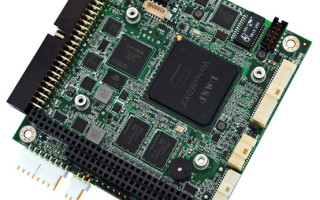The Past, Present, and Future of PC104 for Small Form Factor Designs
June 30, 2020
Blog

PC104 has been around for over 30 years. That?s a long time, even for embedded systems. Despite that age, it remains a viable and important architecture for embedded systems.
PC104, or what used to be PC/104, has been around in some form for over 30 years. That’s a long time, even for embedded systems. Despite that age, it remains a viable and important architecture for embedded systems. The spec defines a stackable architecture, whereby boards are literally stacked upon each other to add functionality.
A typical stack may contain a CPU board, a power-supply board, and one or more peripheral boards that serve a specific purpose. Such boards are available from a host of vendors. And many OEMs design their own peripherals boards if specialized functions are needed.
The spec, originally developed through the PC/104 Consortium, has evolved over time to keep up with the latest available technologies. It defines the form factors and the buses employed, with the pin-outs. Products that fit this category are intended for rugged industrial and military applications. Originally, two versions were defined, one at 8 bits and one at 16 bits. The latter, being more popular, contained 104 pins. Hence, the “104” designation. It came in at 3.550 x 3.775 in., or 90 x 96 mm, which offered a nice alternative for OEMs looking for a reduced SWaP (size, weight, and power).
Originally, most of the available CPU boards available were based on the X86 architecture and ISA bus. Today, a host of Arm-based CPU boards are available from multiple vendors. And it was typical to run a DOS- or Windows-based operating system (OS) back in the day. Today, we see PC104 systems running all versions of Linux and real-time OSs. Later standards, like EBX and EPIC, allowed for larger CPU boards, but contained a PC104 connector, allowing standard I/O boards to be employed.

The WINSYSTEMS’ PCM-C418 SBC is designed to the PC104 form factor. It offers a low-power spec thanks to the use of a DM&P Vortex86DX3 SoC processor.
The ISA implementation is still widely supported today. Variations have arisen, partly to maintain backward compatibility with existing boards and partly to allow for the use of current technology. For example, the WINSYSTEMS’ PCM-C418 single board computer (SBC) fits the PC104 form factor and features the latest generation DM&P Vortex86DX3 SoC processor. The SBC’s combination of ample memory (2 Gbytes DDR3-LV soldered and 1 Mbyte of battery-backed SRAM) and small size, low power, rugged design, and extended operational temperature range suit it for industrial control, transportation, Mil/COTS, and energy applications.
When higher performance was needed from PC104, the PC104-Plus architecture came into being. This incarnation added 32-bit PCI connectivity, giving OEMs higher speeds while maintaining backward compatibility to existing boards. This was followed by the PCI-104 spec, which is essentially PC104-Plus without the PC104 ISA connector. Products fitting PCI-104 are still available. However, they require the use of a PCIe-to-PCI bridge.
Moving forward, PCIe/104 added PCI Express signaling. This spec originally focused on high-performance CPUs with what is now known as the PCIe/104 Type 1 specification. It permits x16 PCIe lanes on the three-bank, high-speed connector. A PCI-104 connector can be included as well. A future version of this spec (Type 2) allowed for other types of I/O, so designers could move both up and down the CPU performance chart. This is likely the most commonly utilized standard for PCI Express on PC104.
Even with the Type 2 pin-out, many CPUs couldn’t utilize the full three-bank, high-speed connector. So the PC104 consortium approved the Type 3 (OneBank) connector option. OneBank supports the signals of the first bank on the Type 2 pin-out and depopulates the remaining two banks, which were largely unused I/O. This saves real estate on the PCIe/104 CPU, allowing for additional functionality or reduced costs.
A great example of that OneBank architecture can be seen in the WINSYSTEMS PX1-C415 SBC. It’s takes advantage of Intel’s Atom E3900 series SoC processor. Thanks to the OneBank expansion, it can operate as a standalone SBC (no carrier board needed). The backward compatibility of the spec allows for the use of a slew of expansion modules, while still maintaining a small, rugged form factor. And OEMs can design their own modules if necessary.




